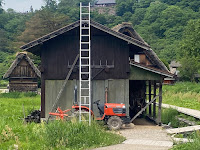Klein: [T]hey are very substantially cuts to the Republican Party’s voters. They’re cuts to Republican states. They’re cuts to Republican hospitals — rural hospitals in areas that vote for Republicans and are very dependent on the care that gets financed by Medicaid in order to stay open.
This is the Republicans’ old ideology coming into conflict with their new coalition.
Yglesias: Absolutely. If you look at the share of people who are on Medicaid by state, there are seven states where more than a quarter of the population is on Medicaid.
One of them is New York, and one of them is California. But the other five are New Mexico, Louisiana, Arkansas, Kentucky and West Virginia.
And then you look at states like Mississippi and Alabama: If they would accept Medicaid expansion funding, there’s a huge, potentially eligible population share in those states.About work requirements and how they've worked out so far, Klein and Yglesias shared this conversation:
It’s a big conflict inside the heart of Republican politics. [Details about Mitch McConnell and Kentucky]
There’s just a conflict between the Republican Party electorate and their ideology, which has shifted in some ways but really remains focused on low taxes, on investment income, low corporate taxes and wanting to cut spending on programs for the poor.
The most conservative states don’t accept Medicaid expansion funds. They have tried to impose work requirements in Arkansas, for example.
So we ran the experiment: Does putting work requirements on Medicaid increase employment? And the answer was no. When they did it, employment didn’t go up. People did lose coverage, but employment didn’t go up.
And Republicans didn’t reverse course after that. They didn’t say to themselves: Oh, our goal here was to get more people working, but we didn’t succeed at that. They said: You know what? This cut the rolls. It cut spending. We’re happy with that.
That’s a free market view: If you want a television, you’ve got to pay for it yourself. If you want chemotherapy, you’ve got to pay for it yourself.
On work requirements, I published this three years ago in Politico.
Here's more from Yglesias, on perverse incentives:
There’s this threat that hospitals will go out of business. I’m in Maine right now in a very rural area, and hospitals don’t have a ton of customers here. If they lose let’s say 10 percent or 15 percent of their customer base and have higher uncompensated care burdens — some of the facilities will just close.
Senate Republicans have discussed creating a hospital bailout fund to prevent this, but it seems crazy to me to address hospitals’ business model problems by giving them direct payments to stay in business even though they’re not treating patients, rather than just letting people get the treatment they need.
SUMMERS: Rural America is poised to be greatly impacted by these proposed cuts. Roughly 20% of the U.S. population lives in rural areas where Medicaid covers 1 in 4 adults. Here to talk about what could be at stake for those communities is Sarah Jane Tribble. She's the chief rural correspondent for KFF Health News. ...Sarah, just start if you can by telling us a bit about what you have been hearing from people in rural communities across this country about these proposed cuts.
TRIBBLE: Yeah, I'm not hearing good things. They're very concerned, because Medicaid rates are so high in rural America, that these cuts will be very detrimental, they'll cause more hospitals to close, they'll tax rural health clinics. I was sitting next to a CEO of a rural hospital from Colorado. He has a 25-bed critical access hospital, the only hospital between the Kansas border and Denver on the Colorado I-70 corridor. And he had been talking about the cuts and not happy about them. And then we heard about the rural transformation fund that the Senate has been working on to sort of help offset the cuts. And he leaned over and he just scoffed. He just said, that's just not going to be enough. So I think that there's a lot of concern out there in rural America.



















